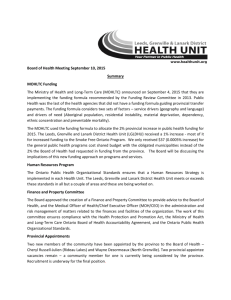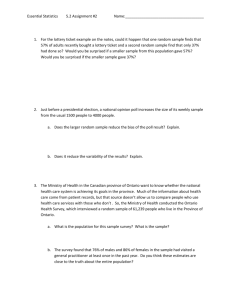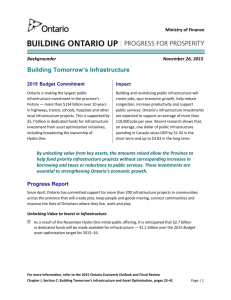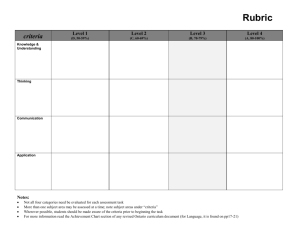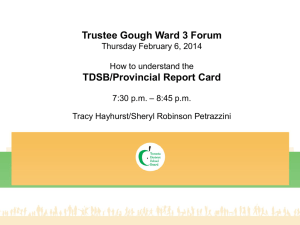OIPPN SWOT analysis for 2013-2014
advertisement
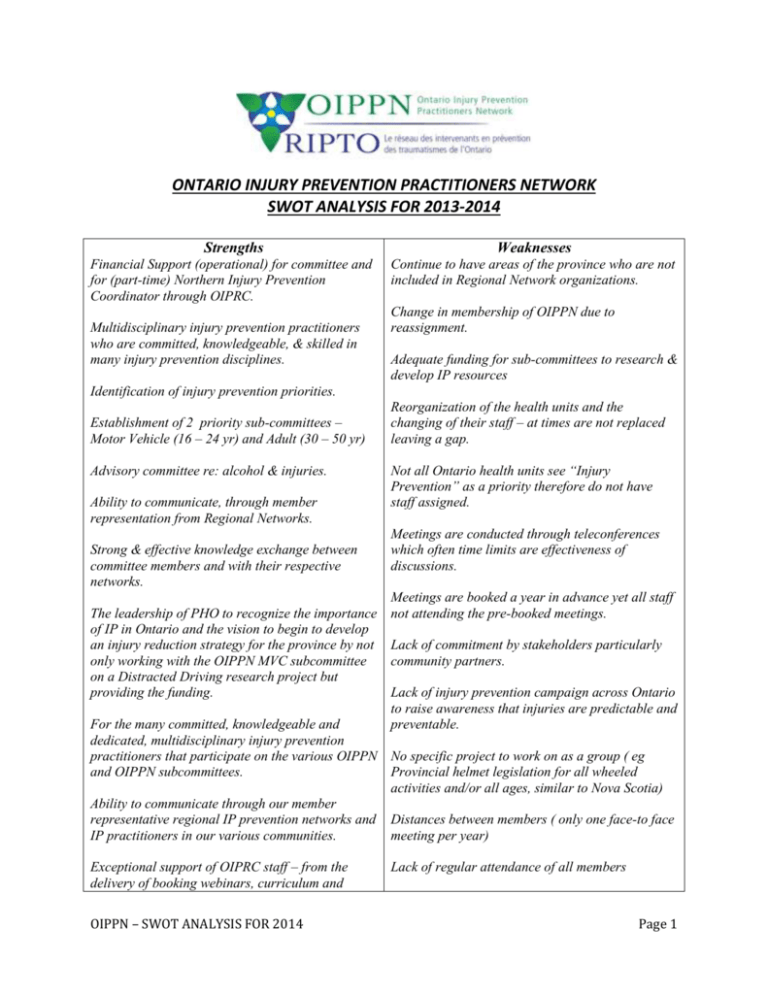
ONTARIO INJURY PREVENTION PRACTITIONERS NETWORK SWOT ANALYSIS FOR 2013-2014 Strengths Weaknesses Financial Support (operational) for committee and for (part-time) Northern Injury Prevention Coordinator through OIPRC. Continue to have areas of the province who are not included in Regional Network organizations. Multidisciplinary injury prevention practitioners who are committed, knowledgeable, & skilled in many injury prevention disciplines. Change in membership of OIPPN due to reassignment. Adequate funding for sub-committees to research & develop IP resources Identification of injury prevention priorities. Establishment of 2 priority sub-committees – Motor Vehicle (16 – 24 yr) and Adult (30 – 50 yr) Advisory committee re: alcohol & injuries. Ability to communicate, through member representation from Regional Networks. Strong & effective knowledge exchange between committee members and with their respective networks. The leadership of PHO to recognize the importance of IP in Ontario and the vision to begin to develop an injury reduction strategy for the province by not only working with the OIPPN MVC subcommittee on a Distracted Driving research project but providing the funding. Reorganization of the health units and the changing of their staff – at times are not replaced leaving a gap. Not all Ontario health units see “Injury Prevention” as a priority therefore do not have staff assigned. Meetings are conducted through teleconferences which often time limits are effectiveness of discussions. Meetings are booked a year in advance yet all staff not attending the pre-booked meetings. Lack of commitment by stakeholders particularly community partners. Lack of injury prevention campaign across Ontario to raise awareness that injuries are predictable and preventable. For the many committed, knowledgeable and dedicated, multidisciplinary injury prevention practitioners that participate on the various OIPPN No specific project to work on as a group ( eg and OIPPN subcommittees. Provincial helmet legislation for all wheeled activities and/or all ages, similar to Nova Scotia) Ability to communicate through our member representative regional IP prevention networks and Distances between members ( only one face-to face IP practitioners in our various communities. meeting per year) Exceptional support of OIPRC staff – from the delivery of booking webinars, curriculum and OIPPN – SWOT ANALYSIS FOR 2014 Lack of regular attendance of all members Page 1 strong and effective knowledge sharing when requested. Difficulty in providing strategic alignment of all networks (competing priorities, etc) Strong leadership from OIPRC and the Northern IP Coordinator Educational opportunities Networking opportunities Lack of funding to support joint activities among members and networks. Foster collaboration between public health staff and community partners Disseminate injury prevention information to stakeholders Provide leadership to stakeholders and subcommittees as necessary Offers structures opportunity for Provincial IP practitioners to regularly connect and share IP information and activities Connection with MTO, PHO offers some opportunity to access funding/research expertise and resources. OPPORTUNITIES Educational opportunities Opportunities for IP practitioners to collaborate on campaigns, events, training, share resources, etc. THREATS Finances – availability of funds to move forward with addressing the priorities Some communities do not recognize IP as a priority Opportunity to have direct dialog with OIPRC and its resources and a close connection with Parachute Reluctance of some areas to be involved with provincial partnership Enhance effective partnerships across the province to address IP Always the threat of financial implications from the Ministry – availability of funds?? Facilitate dialogue between practitioners and the public health IP managers If there was to be an Ontario IP Strategy ensure that there was funding to support the strategy Identify sustainable IP programs/initiatives Lack of commitment by stakeholders particularly community partners Opportunities to have consistent messaging across the province and dollar savings through joint OIPPN – SWOT ANALYSIS FOR 2014 Page 2 programs/resource development & production Distance Opportunities to align work of regional committees Loss of support from OIPRC or loss of funding for teleconference Opportunity to work with Public Health Ontario and to speak of the importance of injury prevention Opportunities for all Health Units to take the curriculum for falls and injury prevention free of charge when booked in advance. Or by e-learning for charge by booking. Lack of movement in provincial strategy Retaining/obtaining members Northern Conference held in North Bay was a great opportunity for “Northern Injury Prevention Practitioners” to attend an educational session. With representatives from all regional networks on OIPPN there is an opportunity to possibly start working on a project together provincially. (OIPPN MVC – Distracted Driving ) Falls and MVC in the age group 30-50 may have a project. Opportunities to develop a Ontario Injury Prevention Strategy – identify three common priorities for all health units and ensure that funding is attached to the strategy. Opportunity to have the Managers Alliance Core and the Chairs/Networks group meet at least once a year to discuss future priorities for injury prevention. Provincial/National injury prevention campaign to raise awareness that injuries are predicable and preventable: Use infographic of provincial or national data from OIPRC Declare a week or month dedicated to IP awareness Link with other programs such as Built Environment/Active Transportation to raise IP issues (eg Helmet legislation) Networking and resources sharing OIPPN – SWOT ANALYSIS FOR 2014 Page 3 SWOT Analysis – January 2014 OIPPN OIPPN – SWOT ANALYSIS FOR 2014 Page 4
